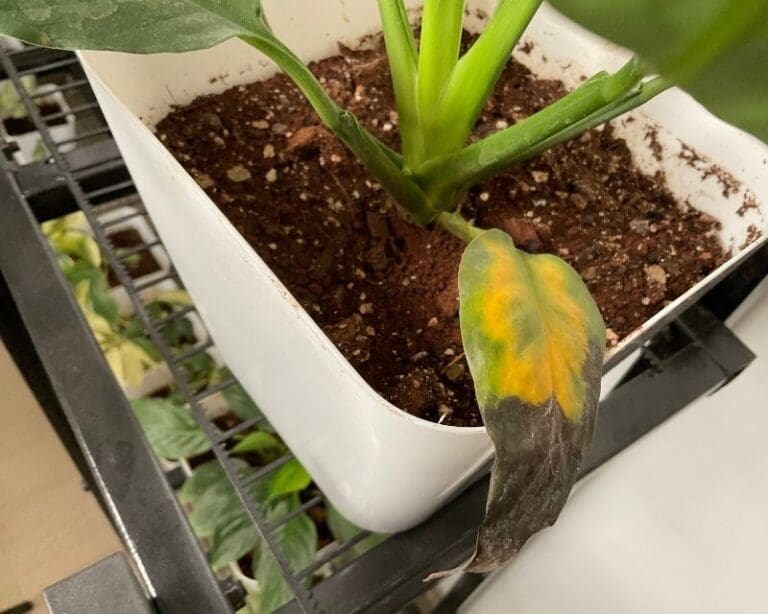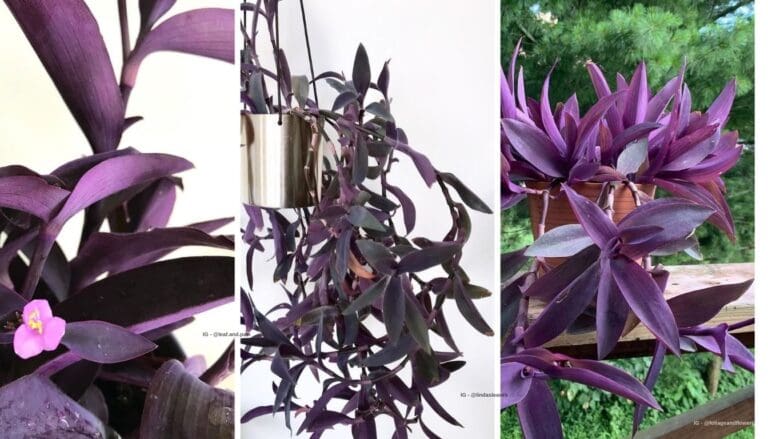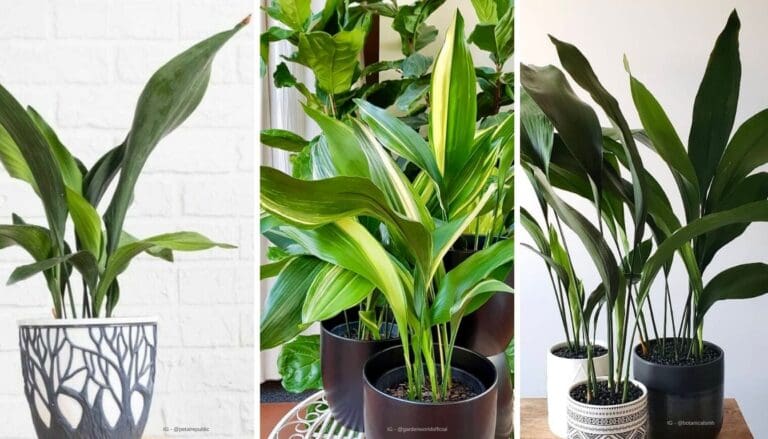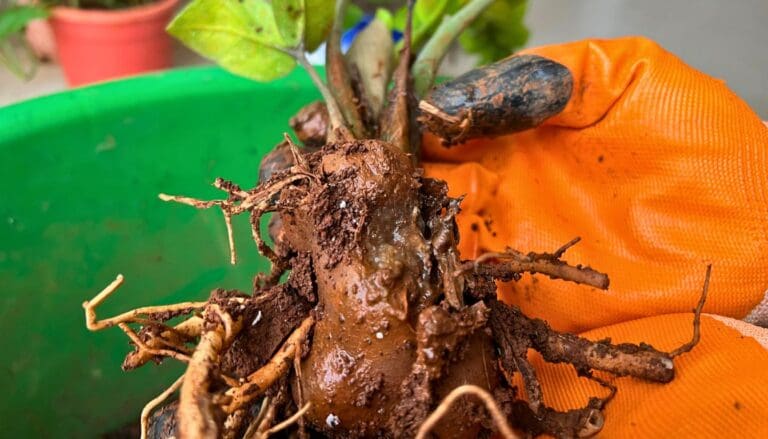Should I Repot My Indoor Plants After Buying Them? (+Steps To Repot)
Repotting the plant is a crucial process that can encourage new growth in the plant. But should you repot your indoor plants just after buying them? Let’s find out!
It is recommended not to repot your indoor plants as soon as you bring them home. This is because plants go through a shocking state due to changes in light, watering, temperature, and humidity. Repotting them at this stage will further stress them out, leading to wilting of the plant.
Sometimes it becomes challenging for the beginners to know if they should repot their houseplants after buying them.
So, in this article, we shall discuss different scenarios when you should repot your indoor plants and when you must avoid doing the same.
We will also learn the pros and cons one may face while doing so. Finally, what are the things that should be kept in mind while doing it? So, kindly go through the complete discussion we have given below.

Please note: Simplify Plants is reader-supported. Some links in the post are affiliate links and I get a commission from purchases made through links in the post.
Should you repot plants after buying them?
First of all, let us learn some common problems we notice in plants when we repot them. There can also be viewed as some cons of repotting indoor plants after buying:
- Drooping or wilting of leaves
- Brown tips
- Stunted growth
- Dropping of leaves
- Stressed plant
Drooping: Drooping is when the leaves curl inward due to stress. They are not receiving proper nutrients and water to stay firm. As a result, they are losing their energy and moisture to keep leaves firm and glossy.
Repotting can affect the entire plant, and the leaves cannot take the stress, and as a result, they lose their firmness.
Brown Tips: When the plant is going through a lot of stress, leaves are the first to reflect it.
The leaves cannot photosynthesize and face problems in producing chlorophyll, which results in brown tips. It can be due to traveling or repotting them further.
Stunted growth: Your plant has already faced stress due to movement from one environment to another. The leaves, roots, and all parts show stress, but it is a severe issue when the plant stops growing.
They have lost all their energy, nutrients, water to grow or even maintain themselves. Repotting has shocked them to such an extent that they have stopped growing at all.
Dropping of leaves: When the plant is stressed due to repotting, the leaves also suffer to stay healthy.
They are left with no more nutrients to stay intact with the plant, or repotting stress has to such an extent that it starts losing all its leaves.
Stressed plant: After repotting, there are high chances that you will notice your plant is unhappy. Even if you create a perfect environment and care routine, they will still suffer to thrive.
It is because they need time and support to come back to normal after repotting. You cannot do it overnight; it may take months for them to have normal health.
Be prepared for the even more stressed plant if you choose to repot. As we told you before that the leaves can wilt, droop, etc. Changing the soil mix can also trigger their stress.
Is repotting plants necessary?

Though there are several reasons to avoid repotting your indoor plants after buying them, sometimes repotting them becomes a necessity. Here are few situations when you should consider repotting them:
- Most sellers use smaller pots to keep their plants to save some extra bucks on the pot.
- Smaller pots often lead to a root-bound situation, which affects the growth of the plant.
- If you see that, repot them in a bigger pot. It is an excellent reason to repot your newly bought plant.
- Many producers use chemical fertilizers or hormones as steroids to make their plants look good, proliferate, and sell them to nurseries or other planters.
- The plant will not last for long without these hormones. Thus repotting the plant into a fresh soil mix becomes necessary.
- If you see your new houseplant’s soil submerged in the pot, it doesn’t have enough soil.
- If the tips of the leaves are brown or the leaves are dull, it means they are droughted, which calls for repotting your plant.
- If you find roots coming out of the pot or the drainage system is not proper, you need to repot.
- The soil mix they are raised in may have additives, including microscopic fungi. These fungi attach to roots and need the plants to have more water and nutrients than they ordinarily would.
- If you notice salt buildup on the plant or planter, then the soil is saturated, and you never know the actual condition of the soil. To make sure the plant stays in good condition, repot them immediately.
Things to keep in mind before repotting

Things to keep in mind before repotting your indoor plants after buying:
- Isolate your newly bought plant as it may take time for the problems (if any) of the plant to show up.
- Give your newly bought plants some time to adjust to the new surroundings of your home because they are already in shock due to moving from one environment to another.
- Hydrate the plant a night before repotting is scheduled by you as it will help the plant to have some relaxation and adjustment with the surrounding atmosphere.
- Examine your newly bought plant and do your research. Schedule your watering depending on the soil mix and pot the plant is growing in.
- If you have bought your plant online, then the best option is to repot them immediately.
- It is because they had already traveled for many days before you received them.
- It’s going through a restoration period and acclimatization period during the transport.
- Also, most of the plants are shipped in a smaller size pot, which makes repotting necessary.
Let’s see what your plant goes through in the transport process:
- An order is received from your end at the nursery.
- The plant is pulled out of its growing area.
- They are groomed and then packed, and then placed in a box.
- They are then loaded onto courier or transport means.
- They travel for 48-72 hours, whether by surface or by air.
- You receive your order at your doorsteps.
As the plants take 2-3 days before they reach your doorsteps, you need to provide a perfect environment to help them acclimate quickly.
Few tips to keep your plants healthy:
- Perform repotting in the evening, as the environment is cool. Thus, the plant gets time to sit in the new pot and save them from a shock-like situation.
- Use permeable pots preferably and make sure the pot has a proper drainage system. Sterilize all the tools you are going to use for repotting your plant.
- If you are using a plastic pot, you need to see the soil mix is aerated as plastic pots hold moisture.
- Use a proper soil mix suitable for your plant, and do not add any chemical fertilizer while repotting.
- Please do not keep the newly repotted plant in full or too much sun as it may cause sunburn to your plant. Please keep them in dim light till you see new growth.
How do you repot a plant you just bought?

You need to follow these simple steps when you repot your newly bought plant:
Take out the plant
Start with cutting the plastic or growing bag in which the plant has come carefully.
If the plant has come in a pot, then gently tap the pot from outside and take the plant out of the pot. Keep the soil moist so that it can come out of the pot quickly.
Soak the plant
Most of the plants get dry and dehydrated during the shipping process.
Soak the plant in a water bucket to dissolve the soil. This will help the soil to come out quickly without damaging the roots and will hydrate the roots so that the roots won’t dry out while repotting.
Note: Do not use your hands to break the soil or force out the plant from the pot.
Choose a pot

It would be best if you chose a container that is perfect for your newly bought houseplant.
It is always suggested to keep the size of the pot about 2’’ bigger than the current size. Give your plant roots plenty of space to support your entire plant.
The pot should have a proper drainage system and porous pots; otherwise, it is of no importance. Containers such as terracotta, ceramic, etc., are unglazed material and can be used for better results.
Also read: What Happens If You Put A Plant in A Pot Too Big?
Prepare your pot
Put a piece of clay that is not flat on the drainage hole and layer 1 inch of some granules of sand in the potting mix, making sure the plant has adequate drainage at the bottom. This will prevent soil from falling out but allows water to drain.
If you are using a terracotta pot, soak it ahead of time as they absorb moisture and dry out the plant.
Plant in the pot

Now put the root ball in the middle of the pot such that the crown of the plant should be 2 inches below the top of the pot. This will help the water to go inside the soil properly and prevent spilling over the edge.
Add Soil

Add soil mix suitable for your specific plant. Add it around the plant until it’s even and the plant is upright on its own and supported adequately.
Water the plant thoroughly and let the excess water drain entirely from the bottom of the planter.
Tip: You can add one teaspoon Epsom salt in 1 liter of water and water your newly repotted plant with it. This will promote your plant’s growth and will recover from the shock after repotting easily and rapidly.
Final words

We can conclude that repotting the indoor plant after buying can be decided only after watching the current situation of the plant.
In some conditions, repotting your plant might do more harm than good, while it becomes necessary to repot your plants in others.
It would be best to evaluate the situation of your plant and then take a call to repot them. Always prefer keeping them in the same pot unless needed.
Also read: 9 Indoor Gardening Mistakes That You Didn’t Realize You Are Making
Sources: The Pennsylvania State University, The Royal Horticultural Society.
Recommended Garden Supplies
| Product Image | Our Recommended Gardening Supplies | Check Offers! |
|---|---|---|
Top Top
Top
Top
Top
Top
Top
Top
Top | rePotme Houseplant and Tropical Classic Potting Soil Mix | Check Offer On Amazon |
 Top
Top
Top
Top
Top
Top
Top
Top | Espoma Organic Indoor Plant Food | Check Offer On Amazon |
 Top
Top
Top
Top
Top
Top
Top
Top | GooingTop LED Grow Light 6000K Full Spectrum Clip Plant Growing Lamp | Check Offer On Amazon |
 Top
Top
Top
Top
Top
Top
Top
Top | Soil Moisture Meter | Check Offer On Amazon |
 Top
Top
Top
Top
Top
Top
Top
Top | Govee Hygrometer Thermometer, Bluetooth Enabled! | Check Offer On Amazon |
 Top
Top | LEVOIT Humidifiers for Large Room(Best For Plants) | Check Offer On Amazon |
 Top
Top
Top
Top
Top
Top
Top
Top | Upgraded DIY Automatic Drip Irrigation Kit, 15 Potted Houseplants Support | Check Offer On Amazon |
 Top
Top
Top
Top
Top
Top
Top
Top | Stainless Steel Heavy Duty Gardening Tool Set | Check Offer On Amazon |
 Top
Top
Top
Top
Top
Top
Top
Top | Bonide Insecticidal Soap | Check Offer On Amazon |
 Top
Top
Top
Top
Top
Top
Top
Top | Bonide 32 oz Spray Neem Oil for Organic Gardening | Check Offer On Amazon |
 Top
Top
Top
Top
Top
Top
Top
Top | Garden Safe Fungicide | Check Offer On Amazon |







Give your plant oblique mild, well-draining soil, and a moderate amount of moisture,
and it should thrive.